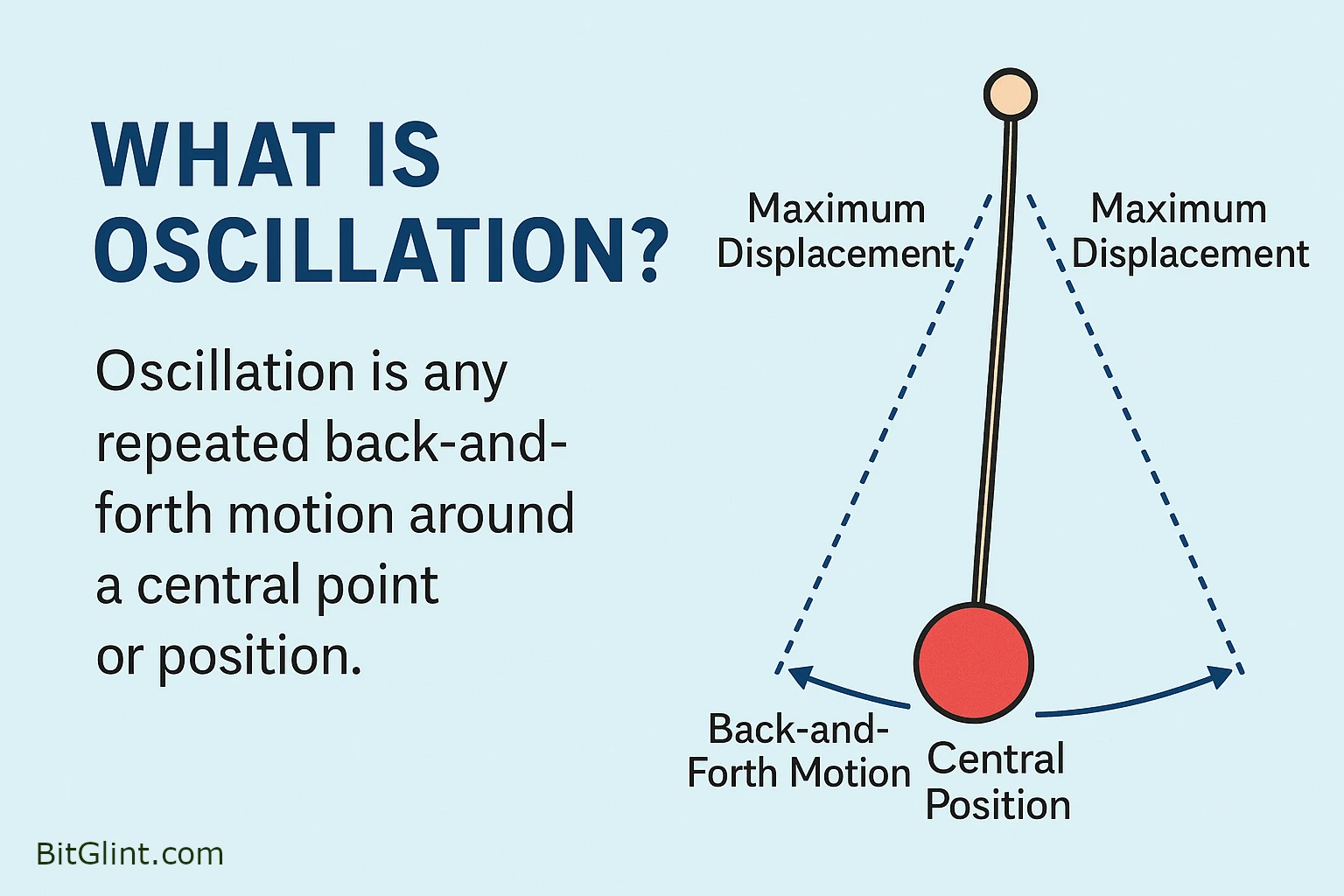Oscillation is everywhere around us, whether we realize it or not. From the gentle swing of a playground swing to the tiny vibrations inside an atom, oscillations are a natural part of how the world works. Understanding what oscillation is—and seeing examples of it in everyday life—can make science feel much more connected to real human experience.
In this article, you’ll find 50 clear and practical examples of oscillation. We’ll look at how oscillations show up in mechanical systems, electrical circuits, sound waves, natural phenomena, and even inside your own body. Each example will help you see just how often repeated, rhythmic motion shapes the environment we live in.
If you’ve ever been curious about the swinging of a pendulum, the vibration of a guitar string, or the way waves crash at the beach, you’re in the right place. Learning about oscillation isn’t just about physics—it’s about understanding one of the most common patterns found in nature and technology.
What is Oscillation?
Oscillation is any repeated back-and-forth (or cyclic) motion around a central equilibrium position. In physics and engineering it describes an object, particle, or system that moves in a regular, periodic way over time—such as a swinging pendulum, a vibrating guitar string, or the rise and fall of ocean waves.
Oscillation arises when a system is displaced from equilibrium and a restoring force pulls it back. If energy losses are low or energy is continually supplied, the system usually overshoots, reverses direction, and repeats the cycle, producing sustained motion known as periodic oscillation (simple harmonic motion being the simplest case).
Oscillatory behaviour appears across disciplines:
-
Mechanical – springs, pendulums, bridges
-
Electrical – alternating current, LC circuits, quartz crystals
-
Biological – heartbeats, circadian rhythms, neural firing patterns
-
Wave phenomena – sound-pressure fluctuations, electromagnetic waves
From atomic-scale lattice vibrations (phonons) to the regular variations in a planet’s orbital parameters, understanding oscillation is fundamental to science, engineering, and everyday technology.

50 Clear and Practical Examples of Oscillation
1. Swing on a Playground
A swing is one of the simplest examples of oscillation. Push it gently, and it moves back and forth. The swing repeats its motion regularly, demonstrating a clear oscillating pattern familiar from childhood playgrounds.
2. Pendulum Clock
Pendulums swing back and forth at a steady pace. This consistent oscillation controls the ticking of clocks, making pendulum clocks precise timekeepers.
3. Guitar Strings
Plucking guitar strings causes them to vibrate and oscillate. This produces musical notes as the string moves back and forth rapidly, creating sound waves you can clearly hear.
4. Tuning Fork
A tuning fork oscillates quickly when struck. It vibrates in a predictable pattern, helping musicians tune instruments accurately.
5. Heartbeat
Your heartbeat oscillates rhythmically, contracting and relaxing regularly. This vital example shows how oscillation supports life.
6. Springs
When you pull and release a spring, it moves back and forth. This is called harmonic oscillation. Springs illustrate clearly how oscillations store and release energy repeatedly.
7. Bungee Jumper
Jumpers bounce up and down when they leap off bridges or towers. The elastic cord causes repeated upward and downward oscillations, demonstrating gravity-driven oscillation.
8. Rocking Chair
Sitting in a rocking chair gently moves you back and forth. This calming motion is a clear, everyday example of oscillation in action.
9. Seesaw
A seesaw repeatedly moves up and down, showing a clear oscillating motion. This playful example is easily observed in parks.
10. Metronome
Musicians use metronomes to maintain rhythm. Its arm swings left and right in steady oscillation, visually marking the tempo of music.
11. Boat Bobbing on Water
A boat floating on water gently moves up and down with waves. This continuous oscillation is easy to visualize and understand.
12. Vibration of Mobile Phones
When your phone rings, it oscillates rapidly. These fast vibrations notify you through quick, repetitive motions. Phones typically use a small motor called a vibration motor (often an eccentric rotating mass or linear resonant actuator) to create rapid oscillations.
13. Earth’s Axial Wobble
Earth’s axis slowly oscillates—precessing and nutating over tens of thousands of years. Though subtle, these long-period oscillations help shape long-term climate cycles.
14. Radio Waves
Radio signals oscillate rapidly. These electromagnetic waves move in repetitive patterns, transmitting sound across distances.
15. AC Electricity
Alternating current (AC) oscillates back and forth. Unlike direct current (DC), this electricity continually changes direction, powering homes and devices.
16. Rider’s Height on a Ferris Wheel
While the wheel itself rotates continuously, a passenger’s vertical position rises and falls in a smooth, periodic oscillation—high, low, high again every revolution
17. Yo-Yo
Playing with a yo-yo creates repeated upward and downward motions. Its oscillation relies on gravity and momentum, creating continuous movement.
18. Vibrating Drumhead
Striking a drum causes its surface to oscillate rapidly. This produces the rhythmic beats familiar in music.
19. Vibration of Bridges
Bridges oscillate slightly under heavy traffic or strong winds. Engineers study these oscillations carefully to ensure structural safety.
20. Washing-Machine Agitation Cycle
During the wash (not spin) cycle, the drum rocks back and forth, sloshing water and clothes. This deliberate oscillation loosens dirt efficiently.
21. Car Suspension System
Shock absorbers oscillate to smooth the ride. They move up and down rapidly, absorbing bumps and vibrations for passenger comfort.
22. Child Jumping on Trampoline
Bouncing up and down on a trampoline clearly demonstrates oscillation. Each jump repeats the motion, propelled by elastic forces.
23. Oscillating Head of a Desk Fan
Many fans sweep left and right while blowing. This side-to-side oscillation spreads air evenly through a room.
24. Earthquake Waves
Seismic waves oscillate through Earth’s crust. These vibrations travel outward in rhythmic patterns, causing ground shaking.
25. Speaker Diaphragm
Loudspeakers create sound by oscillating a thin cone or dome. The diaphragm moves in and out rapidly, pushing air to generate audible waves.
26. Sound Waves
All sound is produced by oscillating air molecules. Speakers vibrate rapidly, creating audible sound by repeating movements back and forth.
27. Fishing Rod
A fishing rod oscillates after casting. Its flexible tip vibrates briefly, clearly showing energy transferred into oscillation.
28. Diving Board
Jumping on a diving board makes it bounce up and down. The board oscillates repeatedly, converting your movement into energy for diving.
29. Electric Toothbrush
The bristles of electric toothbrushes oscillate rapidly. This repetitive back-and-forth motion cleans teeth effectively.
30. Quartz Crystal in Watches
Quartz crystals oscillate precisely when electrified. These steady vibrations keep quartz watches extremely accurate.
31. Flag in the Wind
Flags oscillate gently as wind flows. Their repeated waving clearly illustrates oscillation driven by air currents.
32. Slinky Stretched and Released Vertically
Pull a slinky toy straight down and let go – its coils bounce up and down in a visible, spring-mass oscillation.
33. Volleyball Net
A volleyball net oscillates after the ball hits it. The slight movements illustrate clearly how energy transfers through oscillation.
34. Helicopter Blade Flapping
As the rotor turns, each blade flexes up and down a little once per revolution. This small-amplitude flapping is an aerodynamic oscillation.
35. Jump-Rope Handle Height
Although the rope itself traces a circle, each handle rises and falls once per turn—an up-down oscillation you can feel in your wrists.
36. Waves at the Beach
Ocean waves oscillate towards and away from shore. Their regular pattern clearly shows how oscillations transfer energy across water.
37. Violin Bow
Drawing a bow across violin strings creates repeated oscillations. These vibrations generate clear, melodic sounds.
38. Piston in Car Engine
Pistons oscillate rapidly inside car engines. Their continuous up-and-down motion powers vehicles efficiently.
39. Oscillating Sprinkler
Garden sprinklers oscillate from side to side. This repetitive motion spreads water evenly across lawns.
40. Hammock
Lying in a hammock creates gentle back-and-forth oscillation. Its relaxing motion clearly demonstrates rhythmic swings.
41. Bell Clapper
A bell’s clapper oscillates when rung. Repeated back-and-forth swings produce clear ringing sounds.
42. Air Molecules in Wind Instruments
Wind instruments produce sound through oscillating air molecules. Blowing into them creates rhythmic vibrations audible as music.
43. Pogo Stick
A pogo stick’s spring compresses and extends with each jump, creating a clean up-down oscillation that propels the rider.
44. Electric Fans with Oscillation Feature
Fans oscillate left and right, distributing air evenly. This steady side-to-side movement shows oscillation clearly in everyday use.
45. Tree Branches in Wind
Branches oscillate gently when wind blows. These rhythmic movements visually demonstrate oscillation in nature.
46. Buoy on Water
Ocean buoys oscillate with waves. They move up and down rhythmically, clearly illustrating how water transfers energy.
47. Coastal Tides
Sea level at the coast rises and falls in a steady rhythm, driven by the gravitational pull of the Moon (and to a lesser extent, the Sun). This large-scale oscillation moves vast amounts of water twice each day, creating the predictable high-tide / low-tide cycle familiar to sailors, surfers, and coastal residents.
48. Balance Wheel in Mechanical Watches
A coiled spring drives the tiny wheel to rock back and forth at around 5–10 Hz, regulating the watch’s gear train.
49. Wobbling Spinning Top
A spinning top wobbles as it slows. Its oscillations become more visible, clearly demonstrating how rotational energy dissipates over time.
50. Skier Carving Alternating Turns
A skier rhythmically leans left then right, tracing a repeating S-shape down the slope—an actively controlled side-to-side oscillation driven by balance and momentum.
How Oscillation Affects Your Daily Life
Oscillation isn’t just a concept in physics textbooks. It’s something you experience every single day. From the moment you wake up, oscillations shape how you interact with the world around you.
Take your morning routine, for example. The alarm on your smartphone buzzes to wake you up. That vibration? It’s an oscillation happening hundreds of times per second. The microwave you use to heat your breakfast relies on oscillating electromagnetic waves to quickly and evenly warm food. Even brushing your teeth involves oscillation, as electric toothbrushes move rapidly back and forth to clean your teeth efficiently.
During your commute, the concept of oscillation stays relevant. When you listen to the radio, you’re picking up oscillating radio waves that carry sound from the station to your speakers. Your car’s suspension system oscillates each time the wheels hit a bump, absorbing shocks and keeping your ride smooth. And every time you cross a bridge, engineers have carefully studied oscillations to make sure it stays stable under heavy loads.
In the workplace or at school, oscillations are still everywhere. The clocks on the walls are regulated by tiny oscillating quartz crystals. Your Wi-Fi signal at home travels through oscillating electromagnetic waves, invisible to the human eye but essential to staying connected.
Even your own body runs on oscillations. Your heartbeat follows a rhythmic oscillation, contracting and relaxing thousands of times a day. Brainwaves oscillate continuously too, shifting patterns as you move from alertness to deep sleep.
Understanding oscillation can shift your perspective. It helps you notice the hidden mechanics behind your daily routines. Next time you swing in a hammock, play a musical instrument, or simply glance at your watch, remember: oscillation isn’t just science — it’s life.
Why So Many Things Oscillate
Look around and you’ll notice a pattern: the world likes to repeat itself. A swing moves back and forth, a heart beats in steady time, and electric current flips direction sixty times a second. So why do so many things oscillate?
A push and a pull
Most systems have a restoring force. Stretch a spring and it pulls back. Push air molecules and pressure pushes back. This simple push-pull balance makes repetitive motion—the oscillation—almost unavoidable.
Energy prefers round-trips
In an oscillator, energy shuttles between two forms. A pendulum trades height for speed, then back again. Nothing new has to be added each cycle, so the motion is efficient. Nature rewards efficiency.
Symmetry counts
Many objects are built—or shaped by physics—with a natural symmetry point. Move away from that point and forces appear that steer things back, but they seldom stop exactly at center. Overshoot happens. The result is a rhythm.
One frequency wins
Every oscillator has a natural frequency. Add a nudge at just the right rate and the motion grows; hit a different rate and nothing much happens. Engineers call this resonance. It explains why bridges can shake in the wind and why a guitar string rings at a set pitch.
Feedback locks in the beat
Biological clocks, quartz watches, even some economic cycles rely on feedback loops. The system measures itself, corrects itself, and keeps ticking. Feedback plus a delay often equals periodic motion.
What this means for you
Oscillations make clocks reliable, radio signals clear, and medical devices dependable. Your daily life runs on these quiet back-and-forth movements—most of them unnoticed until they stop.
Key takeaway:
Things oscillate because a restoring force, efficient energy exchange, symmetry, natural frequency, and feedback come together. This combination makes periodic motion the simplest, most stable solution for countless systems—from atoms to skyscrapers.
Read also: 20 Entropy Examples & Definition
The Most Popular on BitGlint

Top 100 Personal Items List
Everyone uses personal items in their daily lives, often without even thinking about them. From the moment you wake up...

30 Defiance Examples & Meaning
Defiance is something most people experience at some point in life. You feel it when you say no to something that...

Top 30 Desire Examples & Definition
Desire is a powerful force that drives much of human behavior, shaping our goals, dreams, and everyday decisions. It's...

100 Non-Digital Things List
In everyday life, there are still hundreds of objects, tools, and materials that exist completely outside the digital...

30 Examples of Attention & Definition
Have you ever noticed how a catchy tune can grab your attention, even when you're busy doing something else? It's...

60 Cultural Traditions Examples & Definition
Cultural traditions are part of daily life - whether people realize it or not. They shape what we eat, how we...

Top 30 Intimacy Examples & Meaning
Intimacy goes beyond physical touch or romantic moments. It’s about closeness, trust, and connection. In everyday...
Get Inspired with BitGlint
The Latest
40 Emotional Value Examples & Meaning
Why do some messages stick — while others are forgotten? Why do people choose one brand over another, even when the product is the same? The answer often comes down to emotional value. Emotional value is what makes a message feel human. It’s the emotional connection...

30 Teasing Examples & Definition
Teasing is a common part of human interaction. People tease in different ways, for different reasons. Sometimes it is friendly. Sometimes it can hurt feelings. Understanding what teasing means and seeing clear examples helps everyone handle these moments better....
40 Thought Experiments for Curious Minds
Some questions can’t be answered with a simple yes or no. Some problems don’t have a clear solution. That’s where thought experiments come in. They aren’t just old ideas from philosophy books. Thought experiments are tools we still use to think through problems, test...
Hermaphrodite: 20 Human Examples & Meaning
Hermaphroditism in humans is a complex and fascinating topic that raises many questions. Are there true human hermaphrodites? What do hermaphrodites look like? Can a hermaphrodite have both working male and female reproductive parts? These are common questions people...

